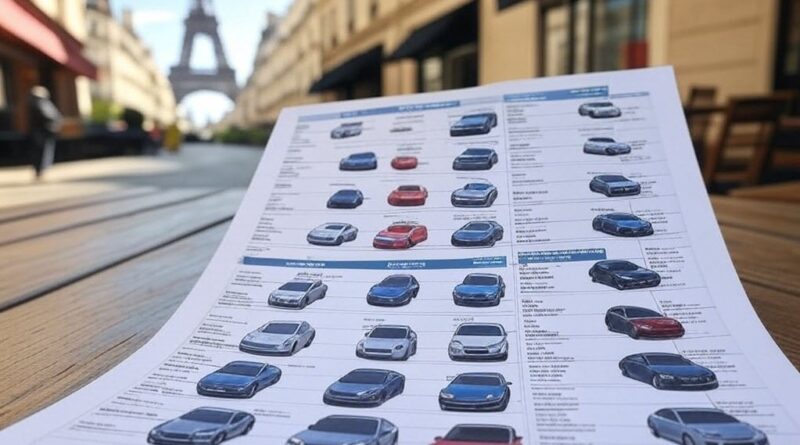France Car Buying Cheat Sheet: What You Need to Know
Thinking about buying a used car in France? Whether you’re a local or new to the country, the process can feel a bit overwhelming. But don’t worry — this cheat sheet breaks it all down so you know exactly what to check and what to expect. France gets most of its cars from: Used car imports, mainly from Germany and Belgium. Local brands built in France. Neighboring EU countries with shared manufacturing (Germany, Spain, Italy)
Where Does France Get Most of Its Cars From?
✅ 1. Domestic Production
France is still home to major car manufacturers like:
- Renault
- Peugeot
- Citroën (part of Stellantis)
Many new cars sold in France are made locally, especially small to mid-size models.
However, over the years, a lot of manufacturing has shifted abroad — even for French brands.
✅ 2. Imported Cars: Top Countries France Imports From
According to recent trade data, France imports a large number of vehicles from:
| Country | Why |
|---|---|
| Germany 🇩🇪 | Luxury & mid-range (Volkswagen, BMW, Mercedes, Audi) |
| Spain 🇪🇸 | Economical hatchbacks & French-brand models built there |
| Slovakia 🇸🇰 | Kia, Hyundai, and VAG Group production |
| Italy 🇮🇹 | Fiat and other Stellantis models |
| Czech Republic 🇨🇿 | Škoda and some Hyundai/VW models |
| Japan & South Korea 🇯🇵 🇰🇷 | Toyota, Nissan, Kia, Hyundai |
🚘 Germany and Spain are consistently the top two sources for car imports into France.
🚗 Used Car Imports (Occasion Market)
For used cars, many are imported from:
- Germany (ex-lease and fleet cars)
- Belgium and the Netherlands (clean histories, well-serviced)
- Italy (especially southern regions with less rust)
These are popular in the private resale and dealership markets.
✅ 1. Always Check the Car’s History
Before you fall in love with any car, ask the seller for a Histovec report — it’s free and official.
This report shows:
- How many owners the car’s had
- If it’s been in any accidents
- Odometer readings (mot history)
- If it’s under finance or reported stolen
👉 You can get it from histovec.interieur.gouv.fr. If the seller won’t give it to you — walk away.
✅ 2. Make Sure the Paperwork’s in Order
Here’s what the seller should give you:
- The Carte Grise (car’s registration certificate)
- A valid Contrôle Technique (MOT-style test) if the car is over 4 years old
- A signed Certificat de Cession (proof of sale form)
- A Certificat de non-gage (shows there are no debts or legal issues)
✅ 3. Don’t Skip the Inspection
Even if the car looks great, it might be hiding issues.
It’s worth getting a local garage or independent mechanic to give it a once-over — especially to spot:
- Odometer fraud
- Poor accident repairs
- Rust or engine issues
- Diesel emission faults
✅ 4. Know the Extra Costs
Besides the price of the car, you’ll also pay:
- A registration tax (based on engine size, emissions, and region)
- Possibly a pollution tax if it’s high-emission
- A Crit’Air sticker if you plan to drive in low-emission zones
✅ 5. Final Step: Register the Car
Once the deal is done:
- The seller marks “sold on [date]” on the Carte Grise
- You register the car online at the ANTS website within 30 days
- You’ll get a temporary certificate, then the new Carte Grise by post
✅ That’s it — the car is legally yours.
🚩 Watch Out for These Red Flags
- The seller refuses to give the Histovec report
- The car has been freshly repainted in spots
- They’re rushing you or asking for cash-only
- The car has foreign plates (registration gets complicated)
Final Tip
Buying a used car in France isn’t too difficult — once you know what to look for.
Check the history, inspect the car properly, double-check the paperwork, and register it in time.
Take it slow and ask questions — you’ll drive away with a great deal and peace of mind.
Buying a used VW. Buying used vauxhall, BMW, Jaguar, Ford, Volvo, Range rover, Bentley, Aston Martin, Porsche, Ferrari, Lamborghini, Maserati, Hyundai, Tesla, Honda, Pagani

